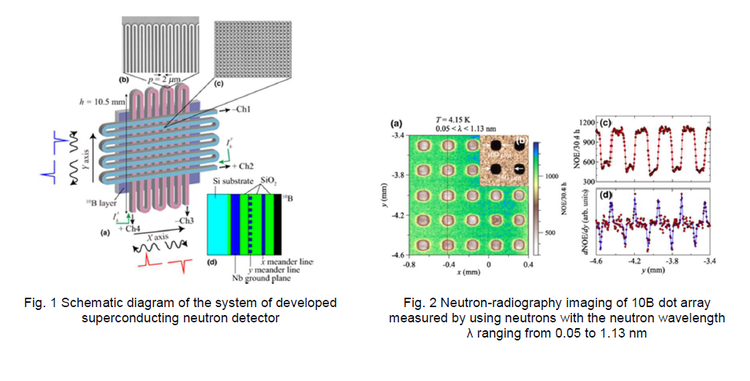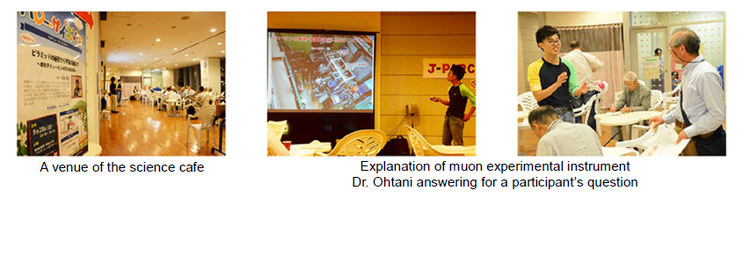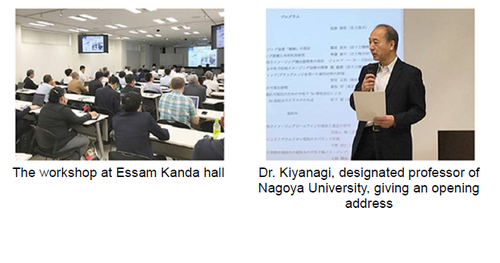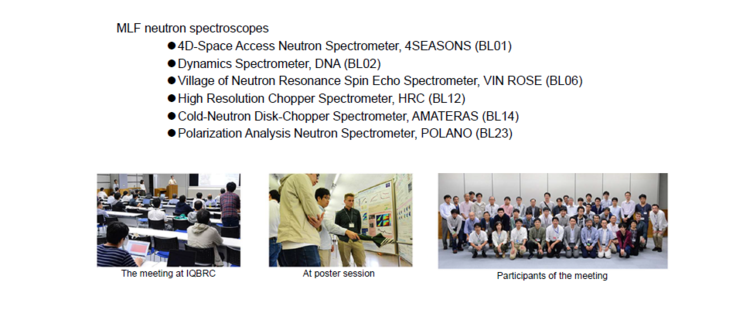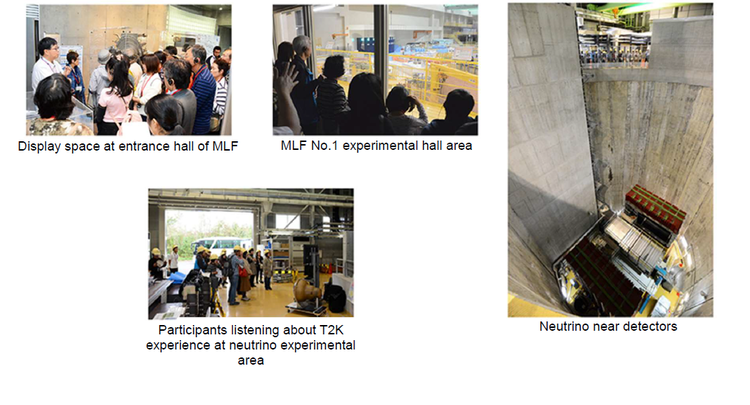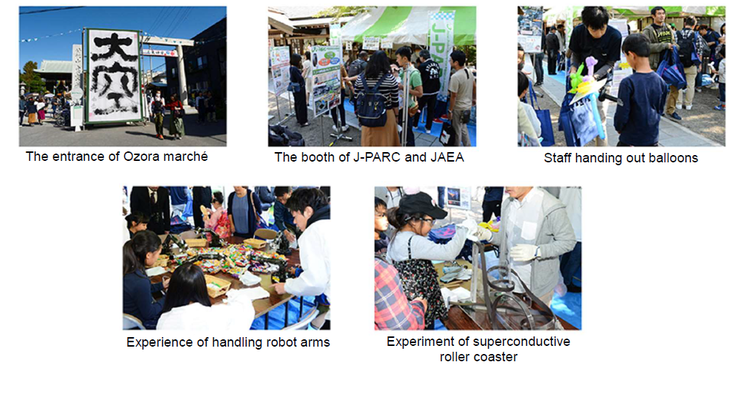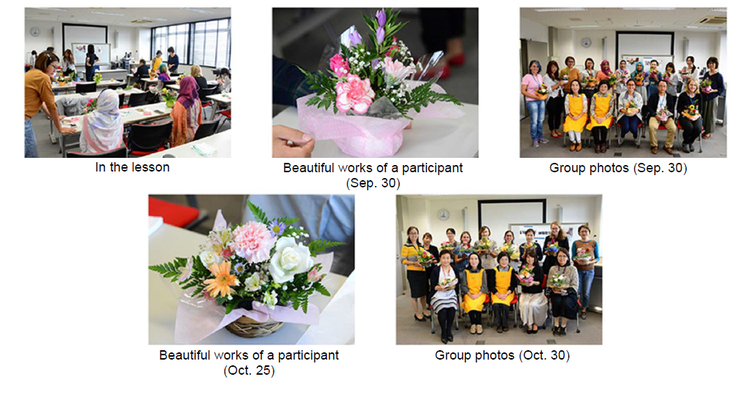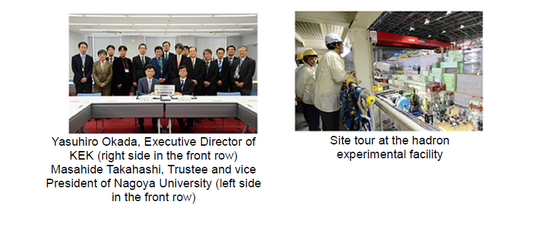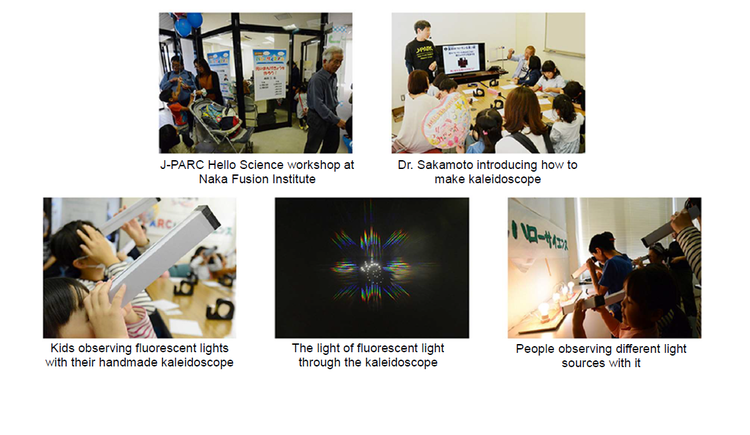J-PARC NEWS October 2018 (Issue #162)
■ Solid-state one-chip high-speed neutron-imaging system using a superconducting detector developed (October 23, 2018, news release)
A group of J-PARC researchers developed a high-speed neutron-imaging system using a solid-state superconducting detector, of which the operating principle is totally different from conventional neutron detectors. The group consists of Hiroaki Shishido, an associate professor of Osaka Prefecture University, Kenji Kojima, a former member of the Muon Science Section of J-PARC Center and currently a researcher at TRIUMF in Canada, Masahide Harada, a JAEA researcher and a chief researcher of the Neutron Science Section of J-PARC Center, and Takayuki Oku, a JAEA researcher and a manager of the Technology Development Section of J-PARC Center. The system employs a time to digital converter modified from the Kalliope circuit developed by Kojima and others. The system proved its revolutionary high space resolution of 22 μm during a neutron-imaging demonstration experiment using BL10 of the Materials and Life Science Experimental Facility (MLF). The achievement is expected to contribute to more precise non-destructive inspection. This research was supported by the Grant-in-Aid for Scientific Research on Innovative Areas (A) (Principle investigator, Takekazu Ishida, Guest Professor of Osaka Prefecture University). https://journals.aps.org/prapplied/abstract/10.1103/PhysRevApplied.10.044044
■ J-PARC Science Cafe, Hello Science Workshop, held, featuring "Forefront of Research on the Elementary Particle Muon: From the Secrets of the Pyramids to the Mysteries of the Universe" (On September 28, 2018, at Tokai Village Industrial and Information Plaza, iVil)
J-PARC Science Cafe in September held a lecture, "Forefront of Research on the Elementary Particle Muon" by Masashi Otani, a KEK assistant professor and a member of the Accelerator Section VII of J-PARC Center. His topics included: (1) the discovery of unknown giant spaces within pyramids from the observation of the highly penetrative cosmic-ray muon hitting the earth, (2) a world-first successful acceleration of artificial muon generated by a group of researchers at J-PARC including Otani, and (3) the future research to accurately measure anomalous magnetic moments (g-2)* by using the accelerated muon. The g-2 experiment is expected to explore the mysteries of the universe such as dark matter. The lecture this time had many new participants.
* Magnetic moment is the strength of the magnetic characteristics of muon, and anomalous represents a difference from the Dirac equation's calculated value of 2, which is considered to have some traits of dark matter and others, in addition to the currently known effects of the equation to govern the entire universe.
■ The Sixth Pulse Neutron Imaging Workshop held (On October 10, 2018, at Essam Kanda Hall, Tokyo)
Since its opening for shared use with the public in 2015, "Raden," the world-first pulse neutron-imaging system built within the Materials and Life Science Experimental Facility (MLF) has been widely used by not only researchers of universities and laboratories in and outside Japan, but also by researchers of private companies in Japan. In addition to the above shared use with the public, the sophistication of energy-analysis-type imaging as well as the development of new application techniques utilizing phase information is also promoted. At the sixth workshop this time, the current situation on imaging technology development and application research using pulse neutrons were widely introduced to expand users' understanding and explore new research. With about 60 participants, the workshop had speeches on the current situation of imaging facilities in Japan, technical development, research achievements implemented at Raden, and an introduction of cultural property research featuring Japanese swords, as well as active discussions on the future development of this research.
■ DIRECTION 2018 held (On October 11, 2018, at IQBRC)
On October 11, 2018, DIRECTION 2018, a joint user meeting regarding six units of MLF neutron spectrometers, was held at Ibaraki Quantum Beam Research Center (IQBRC) with more than 50 participants. The meeting included 14 lectures featuring characteristics of each system, introduction of research achievement of new experimental techniques, and the latest conditions of each system. Close discussions were held between equipment manufacturers and users regarding requests on specimen environment and future development. Later, during the poster session, 21 topics were presented by the experimental equipment group and their users to actively exchange frank opinions on the future research and sophistication of equipment.
■ J-PARC receives visitors of a bus tour, 2018 Autumn Ibaraki Good Place Plan: Experience Bus Tour in Central Ibaraki Area (On October 14, 2018)
Ibaraki Prefecture is currently organizing several bus tours, 2018 Autumn Ibaraki Good Place Plan.* The Experience Tour in Central Ibaraki Area on October 14, Sunday, included viewing of kochia flowers (burning bush) in Hitachi Seaside Park, lunch at Nakaminato Fish Market, and a facility visit to J-PARC Center. The tour attracted about 40 persons including those from outside of Ibaraki Prefecture. They visited the Materials and Life Science Experimental Facility (MLF) and Neutrino Experimental Facility and received information on the Tokai to Kamioka (T2K) Experiment using neutrinos explained by researchers. Visitors commented that it was a good opportunity to visit there and some said that they needed more time to see it.
* Ibaraki Prefecture organizes bus tours to visit several areas in the prefecture from September to November.
■ Participation in Sixth Ozora Marche 2018 event with a booth, J-PARC Science Experience Corner (On October 21, 2018, at Tokai Village)
The Sixth Ozora Marche event was held at Daijingu and Muramatsusan Kokuzodo on October 21, 2018. This year J-PARC had a joint booth with the Nuclear Science Research Institute, a research division of Japan Atomic Energy Agency (JAEA), to introduce J-PARC experimental facilities by using posters, and research results that led to industrial use, such as commercialization of fuel-efficient tires and development of solid-state ceramic batteries. In the experiment of a superconductive rollercoaster, parents and children experienced and enjoyed the unique behaviors of a superconductive substance cooled with liquid nitrogen. Other activities included giving away balloon art and operational experience of robot arm models. Thanks to good weather, the booth welcomed more than 900 visitors.
■ Flower Arrangement Class held (On September 20 and October 25, 2018, at JAEA-Tokai Administration Building in the Nuclear Science Research Institute)
This is one of several events held by J-PARC to promote exchange between employees and foreign researchers working in J-PARC and JAEA. This popular class attracted more than 20 participants each time. The class held this time featured autumn flowers such as gentian and roses to reflect the season. Under the instructions of teachers from Tokai-mura International Association, participants enjoyed their own style of flower arrangement.
■ Nagoya University branch office established in J-PARC (On October 26, 2018, J-PARC)
On October 26, 2018, a signing ceremony* was held at J-PARC Research Building between the High-Energy Accelerator Research Organization (KEK) and Nagoya University on the memorandum to establish a research base. Under this memorandum, Nagoya University will establish a J-PARC branch office in the KEK Tokai Building #1 to be used by researchers and students of Nagoya University. Nagoya University had already concluded a basic agreement with KEK to work and cooperate with KEK. Teachers belonging to the university's Graduate School of Science and Graduate School of Engineering are jointly working at J-PARC to develop research precision measuring of magnetic characteristics of elementary particles by using a muon beam and studying the physical properties of superconductive materials by using a neutron diffraction method, as well as educating graduate students at the same time. Establishment of this branch office is expected to enhance the close cooperation in research between J-PARC Center and Nagoya University.
* The establishment of a branch office of a university follows the one by Osaka University in March 2016, Kyoto University in February 2017, and Kyushu University in March 2018.
■ J-PARC Science Cafe, Hello Science Workshop, held, featuring "Let's Create an Optical Kaleidoscope" during Nuclear Fusion Facility Visiting Tour (On October 21, 2018, at Naka Fusion Institute, Naka City)
On October 21, 2018, the Naka Fusion Institute, a division of the National Institutes for Quantum and Radiological Science and Technology (QST), received visitors on a facility study tour. During the tour, J-PARC Center offered a craft/experiment class of Hello Science Workshop, "Let's Create an Optical Kaleidoscope." The seven workshops, with a maximum of eight attendants at each time, were presented by Shinichi Sakamoto, a science communicator of the Public Relations Section, and were participated in by more than 80 persons in total including parents of participating children. The lecturer explained the nature of light, different colors, three basic colors, and spectroscopy, and then created kaleidoscopes by using spectroscopic sheets. Parents and children enjoyed the difference in vision due to varied light sources such as fluorescent light, incandescent light, and LED light.

